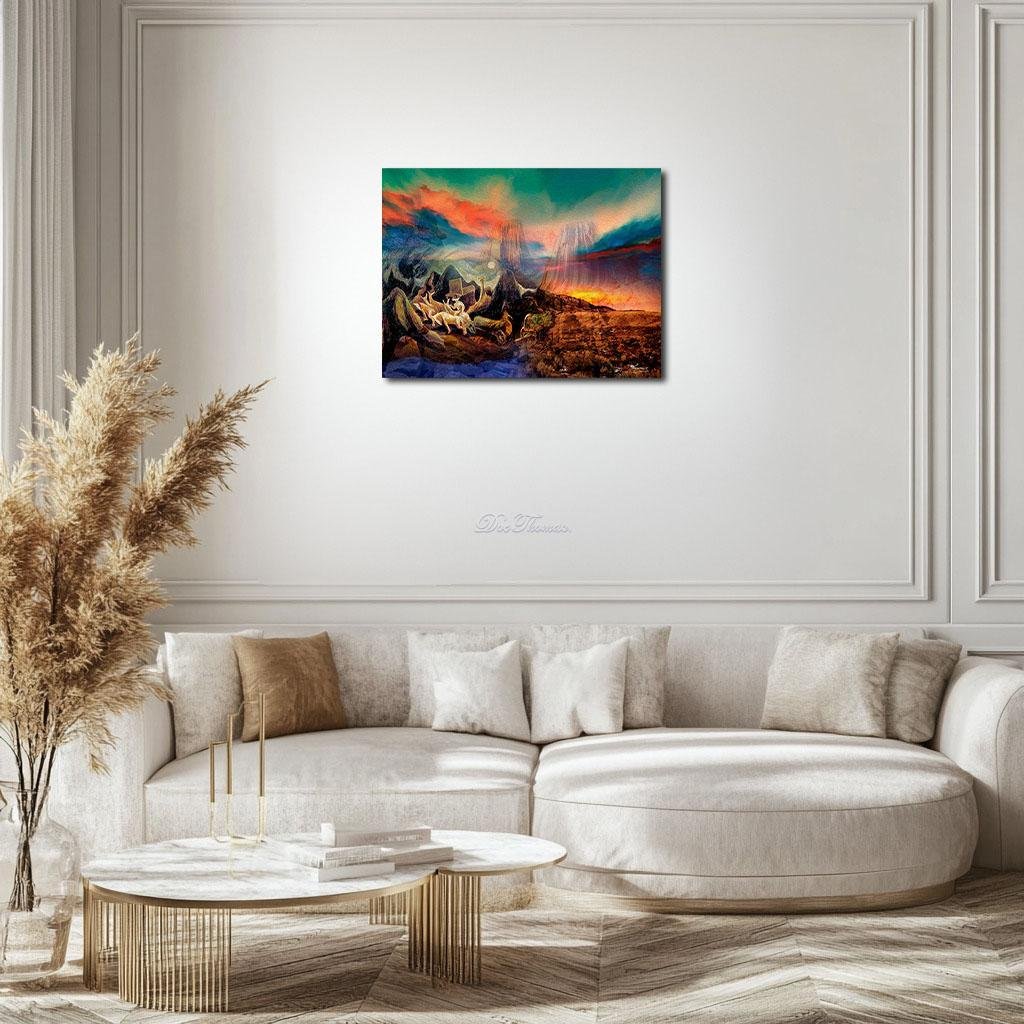Veins of Dust: The Hymn of Splintered Horizons
Veins of Dust: The Hymn of Splintered Horizons transforms Jackson Pollock’s wild vision of the American frontier into a sweeping elegy of motion and memory. Galloping spectral horses and nomadic figures tear across fractured canyons beneath skies ablaze with molten reds, searing oranges, and indigo storms. Towering buttes shimmer like translucent cathedrals, their forms dissolving into cascades of golden light. Amid the cracked earth and endless horizons, this is not a journey toward a destination but a restless search for belonging. A visual symphony of longing and departure, where every hoofbeat echoes through the dust of forgotten dreams.
Please see Below for Details…
Hotline Order:
Mon - Fri: 07AM - 06PM
404-872-4663
Veins of Dust: The Hymn of Splintered Horizons resurrects Jackson Pollock’s Going West as a grand elegy to the untamed spirit of migration, blending the mythic pulse of the American frontier with the fractured memories of a land forever shaped by the wanderer’s footprint. In this reimagining, the restless energy of Pollock’s original vision explodes into a surreal tapestry where ancient landscapes and modern echoes collide under a sky ablaze with the last embers of twilight.
The composition is a collision of eras. In the foreground, Pollock’s wild horses and nomadic figures surge through jagged, dreamlike canyons, their forms ghostly and luminous, painted in the pale glow of spectral ivory. These creatures are not entirely flesh; they exist halfway between legend and reality, their hooves never quite touching the rocky terrain that splinters beneath them. Their movements are urgent, a primal gallop toward a horizon that remains forever just beyond reach.
Behind them, the towering buttes of the American West—Devil’s Tower and Monument Valley’s sacred sentinels—rise like colossal monuments to forgotten deities. These stone cathedrals shimmer as if made of flowing glass, their rugged surfaces transformed into translucent waterfalls of memory cascading into the arid plains below. Sunlight catches their edges in strokes of molten amber and softened copper, blending seamlessly with the horizon where land and sky tremble against one another in a final, fiery embrace.
The sky itself becomes a living force within this piece. To the left, storms of indigo and tempestuous violet swirl against streaks of blood-orange and searing crimson, the remains of a dying sun dissolving into cosmic night. The colors are layered with Pollock’s chaotic intensity—brushed in violent sweeps and gentle dissolves—capturing the tension between arrival and departure, between creation and inevitable decay.
Beneath this sky, the desert unfurls in rough textures of burnt sienna, golden ochre, and weathered umber. The earth cracks under the weight of unspoken histories, each crevice a wound carved by generations of passage. Faint traces of wagon wheels, long erased by the wind, seem to reappear under the shifting light. There is no permanence here—only the haunting reminder that every journey is built upon the bones of the journeys before it.
The color story speaks through its contrasts. Fiery reds and molten oranges pulse with the raw urgency of desire and survival. These blazing tones are met with the calming resignation of cool sage greens and desert blues that veil the distant mesas. Above it all, a soft but unrelenting wash of twilight turquoise stretches across the top of the canvas, a breath of serenity held against the turmoil below.
As an artist, my thoughts while constructing this vision circled the perpetual conflict between conquest and belonging. I imagined the weary hearts of those who traveled westward, seeking more than just land—they sought redemption, reinvention, and a place where their echoes might settle into the vastness. Yet, in their search for new beginnings, they became part of the endless cycle of displacement, their stories tangled among the ancient songs of the land they crossed.
The horses, in this context, are both harbingers of freedom and symbols of flight from one’s own past. They run not toward salvation but into the unknown, their luminous bodies carrying the silent burdens of hopes unfulfilled and destinies uncertain. The towering buttes, magnificent yet crumbling under the weight of their own mythology, watch over it all—silent witnesses to the endless hymn of longing that drifts like dust across the horizon.
In Veins of Dust , I wanted to hold the viewer in that aching pause between sunset and night, between the last golden promise of light and the consuming quiet of uncertainty. It is here that the West becomes more than geography—it becomes a state of mind, an endless journey within the soul, a prayer whispered not for arrival but for the strength to keep moving.
Add your review
Your email address will not be published. Required fields are marked *
Please login to write review!
Looks like there are no reviews yet.








